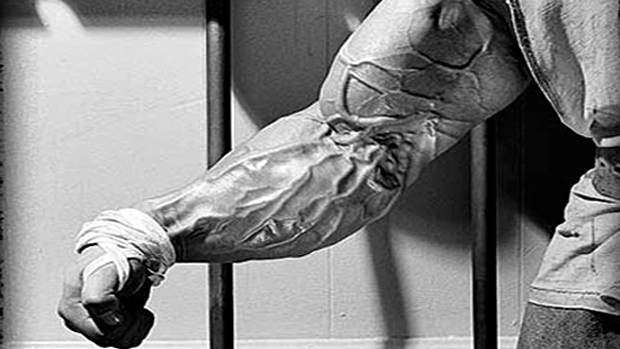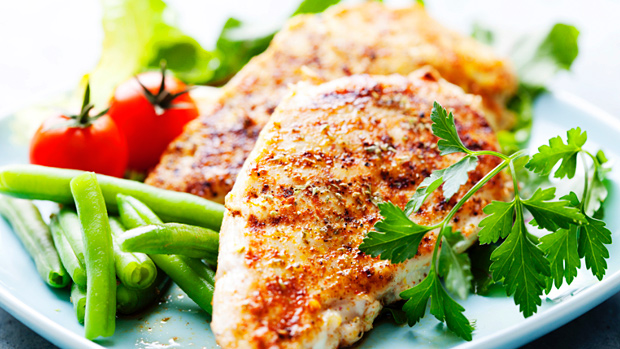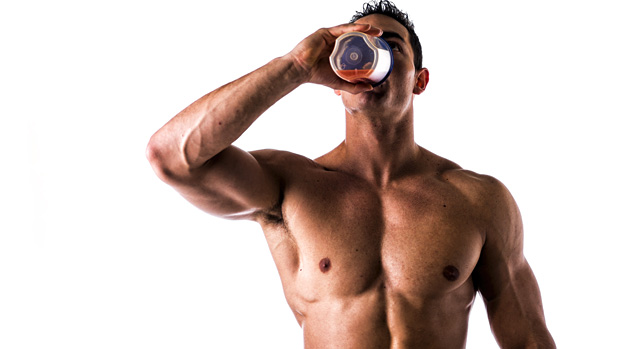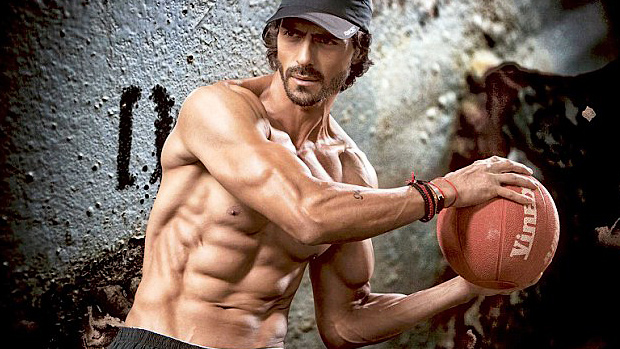In the early 90's, it was low fat and low fat only. Rice
cakes and fat-free Twinkies for everybody!
Then, as the decade progressed, carbs started to fall out of
fashion and the nutrition world turned itself upside down with low
carbs and low carbs only. Great, let's eat Crisco by the
spoonful!
What's next? We almost hate to think about it, so we sat down
with Dr. Christopher Mohr, Mike Roussell, and Chris Shugart and
asked them to think about it. Here's what happened.
T Nation: It's now 2008 and the low-carb trend
is fading. Why all the macronutrient confusion? And can you predict
any new trends?
Mike Roussell: The confusion in nutrition arises because food and
fat loss are big money industries and extreme stuff sells. It's
really interesting if you look back to the original food guide
pyramid that was created in the heart of the low-fat craze. The
cover of the pamphlet handed out by the government said, "Limit Fat
to 30% of Calories."
 |
The media takes pieces of science and blows them up. "Limit fat"
became "cut all the fat out of your diet!" Bodybuilders adopted
this and it worked for them. But in reality most things work for
bodybuilders because we're such an extreme and dedicated culture.
But now we're coming back to reality and embracing the role of
fat in the diet. Fats are powerful compounds as they can modulate
gene expression and hormonal responses in ways that carbs and
protein never dreamed about.
You're right about the low-carb craze being gone in the
mainstream. I knew it was over when Hood changed Carb Countdown
Milk to Calorie Countdown Milk.
 |
I think the future for most people is going to be what we're
doing here on T-Nation right now. Effective fat loss programs are
going to be characterized by moderate carbohydrate intake but low
or no starch intake.
There are studies slowly being published that show this is the
best way for people to lose fat (especially overweight
insulin-resistant people). In the late 90s and early 2000 there was
a lot of fuss about the Glycemic Index. I think that the future is
Glycemic Load (Glycemic Index x grams of carbs) because that takes
into account both the type and amount of
carbohydrates.
Dr. Christopher R. Mohr: Great points, Mike, although the
Glycemic Index is too confusing itself for most people. I once had
a client who didn't know oatmeal was a carbohydrate
(honestly!) and I bet she's not alone. I can't then turn
around and say, "Okay, well, oatmeal is a carb and now
let's calculate the Glycemic Load of your meal with oatmeal."
You know, the confusion lies in the fact that everyone is
looking for a quick fix. Low fat worked, for a period of time,
because it was a way for people to decrease their calories. When
you decrease your calories, you lose weight. Period.
Now, I'm not saying this is the best approach. I'd
like to have people focus more than on a scale, but while Testosteronereaders might understand that and realize the
importance of body composition, the average Joe simply wants to
weigh less. So companies started making everything fat free:
pastries, donuts, cookies, you name it!
But as savvy consumers started reading food labels, they
realized that "fat free" actually meant "high sugar" and often the
fat-free varieties had more calories than their regular-fat
counterparts!
We then had the same thing with carbs when the pendulum swung in
the other direction. All of a sudden, we had carb-free bagels,
pasta, and bread. Um, these foods are carbohydrates – they
shouldn't be akin to cardboard and carb free. Again, it's
a novel way of cutting back on calories by limiting choices. Just
like I said before, cut back on calories, lose weight.
Then just like the low-fat craze, the novelty of the low-carb
craze wore off and we're back to the middle. What's
interesting is that the number of overweight and obese people
just continues to creep higher and higher. Is it really about carbs
or fat?
Here's my prediction: a balanced approach to eating! Crazy,
isn't it? Now keep in mind I'm talking about the average
person here, not someone stepping on stage in their skivvies.
I'm talking to the masses.
Chris Shugart: Mike nailed it here. The confusion comes in when
the media glances over a certain dietary issue, then either waters
it down or misrepresents it. But let's not blanket the evil media
with blame; it's the public's fault for only reading the
dumbed-down headlines, then rationalizing to excuse their poor food
choices.
Example: Bitter, dark chocolate contains some healthy compounds
like phenols and antioxidants. This translates to the headline,
"Health Benefits of Chocolate", and the fat-ass Wal-Mart consumer
says, "Well, golly, chocolate is good for you now! I'll just load
up on Hershey Bars and Cocoa Puffs!"
This is an example of willful ignorance combined with
rationalization. It's pathetic. Need antioxidants? Take a fucking
pill and skip the chocolate, fatty.
As for new trends, I agree with Dr. Mohr. The pendulum has swung
in every direction now, so the only thing left (I hope) is a
sensible approach. Let's just pray that low-protein diets aren't
next. Everyone would look like vegetarians. And that would be
tragic.
T Nation: Okay, there's often a lot of discussion
regarding post-workout nutrition for strength gains, but what about
during periods of fat loss? Do you recommend Surge during periods of fat
loss? Should people throw simple carbs down their throat during
this time?
Dr. Mohr: I do. The key is timing these simple carbs around
their workout. I want people to work out as hard as possible, not
be struggling to make it through their workout because they're
carb and/or calorie deprived.
With that said, the recommendation to use Surge during/after a
workout is for people who work out hard. I was in the gym this
morning and was next to an overweight woman (with her "trainer")
who was drinking a sports drink between her alternating sets of
wrist curls and calf raises. Folks, I wish I could make
stories like that up.
Now, did she really need several extra hundred calories of
sugar-water for her workout? Consider your market and who
you're dealing with. Someone trying to get leaner and improve
his/her body comp, I'm fine with something like Surge, when
you can ramp up the intensity! For the regular person who's not in
the condition to work out intensely and is simply trying to lose
some body mass, leave the recovery drinks on the shelf.
Roussell: I try to keep my clients using Surge and workout carbs
as long as possible. We know now that effective fat loss isn't
about how many total calories or how many calories from fat we burn
during a given session. It's about boosting total 24-hour energy
expenditure and cranking up your metabolism.
I've found that for most of the people I deal with they can
train harder with carbs before/during their workouts. The harder
you train, the more you'll boost your metabolism, and the more
fat you'll lose. So keep the Surge.
Shugart: I've worked with many people on their fat loss diets
and have doubled their workout
drink intake, essentially having them take in Surge pre, during,
and post-training. No fat gain, in spite of the near 100 grams of
simple carbs. I've done this myself for months on end and have
remained in the single-digit body fat range – and I can pack
on fat faster than my ex-wife can max out a credit card.
Long story short, the workout period – just before,
during, and immediately after – is magic time. Even
the most carbophobic person can and should consume a workout drink
like Surge at this time. The benefits are enormous and it doesn't
seem to lead to fat gain in the real word. Of course, carbs should
be limited at all other times in the day.
I'll also add the same caveat as Dr. Mohr: You do have to "earn"
your Surge. No pink dumbbell workouts. And you better be doing some
shit-a-kidney lifting before you double your workout
drink!
T Nation: Anything new in the supplement world on the
horizon (or currently available) that impresses you for fat loss?
Any magic powders coming out?
Dr. Mohr: Yeah, I saw this fantastic infomercial last night that
told me if I simply took a one ounce shot of a special Himalayan
root extract I'd never be hungry again, can live off pepperoni
pizza, and never exercise again! That's unfortunately how
gimmicky most products are out there.
I'm still impressed with green tea. I think EGCG has actually
shown a lot of promise. I like the data that shows simply drinking
tea enhances weight loss (and that's green or black). The best
part about that is even if the fat loss data doesn't continue
to emerge with tea, there are other health benefits, so it's a
win-win.
I also love fish oil. There's been some very interesting
fat loss data on that front too. Like tea, even if that data
doesn't pan out, we know fish oil is absolutely beneficial.
One interesting supplement that's recently emerged is Konja
– it's an Asian root, full of viscous, water-soluble fiber
called glucomannan. Basically, it's like a sponge, and
this viscosity makes a gel in the intestine to slow the rate of
absorption of your meals and help fill you. The fuller you are, the
less you'll consume.
There's also some solid data with it helping lower blood
sugar and cholesterol, but that's a different topic. Keep your
eye on this as I think more science will emerge.
Shugart: The "magic powder" isn't a powder, it's an oil: fish
oil or a blend of EPA/DHA/CLA like Flameout.
Reduced abdominal fat, less fat accumulation in mass phases,
increased insulin sensitivity, improved "handling" of carbs,
boosted metabolic rate, mood elevation, maybe even decreased
hunger... and that's just the fat loss related benefits of
omega-3s and other functional fats. The life extension list is even
longer!
Long story short: Fish oil type products should be purchased
before multi-vitamins and traditional fat burners. They are that essential and that foundational. I think in 2008
this is really going to trickle down to the general population.
Look for Long John Silver's to be advertising how much omega-3 is
contained in their deep-fried fish parts.
Roussell: I'm still really impressed and excited by
forskolin (not foreskin!). I'm hoping more research is going
to be coming out about this in the future.
I also agree with Dr. Mohr. I think that the effect of green tea
and EGCG on fat loss will be further elucidated in the future. I
was speaking with a colleague the other day who has done clinical
trials with EGCG and fat loss. They found some effect in the study
she ran, but she thinks that we need to "crank up the volume" so to
speak with the dosage to see a real effect.
Science really hasn't looked at 900-1000mg dosages of EGCG
a day. That's potentially where we're going to see a
really significant effect.
T Nation: Chris, you mentioned fish oil and its
effects on fat loss, and Mike, you've talked a bunch about
this in your Fish Oil and Fat Loss article.
Anything else since we last published that?
Roussell: I'm going to get a reputation here for being
a fish oil zealot, but yes, especially DHA-rich fish oil.
It was DHA-rich fish oil that showed the significant fat loss
result in the American Journal of Clinical Nutritionpaper in
May of 2007, and it was DHA that has been shown in vitro to
inhibit the formation of mature fat cells from premature ones.
We're only going to see more and more on this very topic.
Like green tea, I think it's a dosage thing. Previously we
haven't had pure enough fish oil products to take the dosages
needed to elicit a fat loss effect. But now science is starting to
explore higher dosages and their effects.
Shugart: The last study I read on fish oil was about how a
depletion of DHA may take part in the pathophysiology of
pedophilia. I'm not kidding. The benefits are truly friggin'
endless. Now there's even hope for Michael Jackson.
Forget welfare cheese and ethanol subsidies; we should at least
spend our tax money on free Flameout for every person in American.
I'm serious, the stuff is damn near a panacea.
T Nation: Let's look now at the 66% of the
population that's overweight or obese. What's spurring this growing
epidemic? Is it carbs? Fat? Lack of exercise? Help solve this
problem!
Roussell: Carbs, calories, and lack of exercise! I
don't want to blame the food industry because Americans need
to get off their fat asses and lift heavy stuff – fast, and often.
But, did you see the article in Men's Health on the
twenty worst foods in America?
A freakin' sub from Quizno's is 1500 calories, and a
Starbucks muffin has over 400 calories. I'm not excusing the
American public for letting themselves be fat, but no one looks at
a sandwich and says, "Hmm, I probably shouldn't eat the whole
thing because that would be over half my caloric needs for the
day."
Starchy carbs are another problem. They are so portable and easy
to consume that people don't think twice about them. I know 30
year old guys who won't drink Coke but will suck down a 32oz
Gatorade because they used to be an athlete. Just because
you drank Gatorade ten years ago as a college football player
doesn't mean you should still be drinking it in your cubicle
with your belly hanging over your belt.
Shugart: Good stuff, Mike! Now, here's something that most
people don't know. The hunger sensation and the pleasure we get
from eating is classified as a sensual desire. The desire to
eat and the feeling of hunger are close cousins to the sex drive.
In other words, very, very powerful mojo.
Well, in today's society, food is plentiful and cheap. If you
used to want some cake you had to expend a few hundred calories and
a few hours to make it. Now you just go buy one for five bucks.
It's a calorie-orgy out there. Most people can't control these
primitive, innate desires.
It's not a matter of education vs. ignorance either. No diet
recommends tons of sugar, trans fat, and white flour. Fat people
know exactly why they're fat. They know that a bucket of ice
cream is bad, but they eat it anyway. The solution goes way beyond
teaching people about good vs. bad carbs. It's going to take major
behavior modification and psychological bitch-slapping. That's what we're missing.
Dr. Mohr: Yes, it's surely carbs, calories, and lack of
exercise, but you can't leave out fat and simple portions. I
recently contributed to a book that will be coming out in 2008 and
looked at the worst of the worst fast foods. There are surely a lot
to choose from, but my favorite one was at an unnamed "Italian"
restaurant. (The name sounds like "Backaroni Mill.")
They offer a single serving meal that's 2220 calories, 148 grams
of fat (52 saturated), and 126 carbs. Good thing I have a PhD,
because I would otherwise struggle to figure out why over 66% of
the population is overweight! Portions are absolutely insane;
it's actually kind of disgusting.
And here's where not enough people are focusing their
efforts – behavior change! Like Chris said, I have a feeling that
most people know living off Big Macs isn't the best idea. But how do we get people to change their habits?
I know a percentage of the population can use Nike's saying
and "just do it," but it's not that simple. Let's look at
strategies for permanent success, not a quick fix, cut out carbs or
fat, cookie-cutter program. People need to learn how to grocery
shop (hence our creation of the DVD Grocery Shopping Made
Easy), how to cook very simple foods (Berardi's Gourmet
Nutrition is a good start), and just go back to basics.
Here are four such rules:
1. Eat a fruit and/or at least one vegetable with every single
meal.
2. Plan ahead. Don't go to work without any food at all,
then wonder why you opted for fast food at noon, hit the vending
machine at 3 PM, and are famished on the way home so you decided to
order a pizza to pick up for dinner.
3. Define your goals and write them daily. If you don't
know what you're working toward, you're going to continue
to struggle.
4. Move more! I'm all about complexes, interval training,
large body movements like deadlifts, etc. but what about the other
160-plus hours during the week when you're not at the gym?
Walk more. Get on a bike and use that as your transportation. Use
the stairs instead of the elevator.
And don't laugh thinking these are too simplistic for
T-Nation readers. Here's a picture I took from the 2007
Arnold. Notice the vacant stairways and the line for the
escalator!
 |
Note: Stay tuned tomorrow for Part II!





